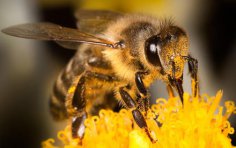
One evening, a swarm of tiny butterflies flew into the room toward the light. We call them poplar moths, or mayflies, because that's about how long they live. We were discussing the topic, and a knowledgeable friend of mine asked me a question: “We're talking about moths, but do you know how long a bee lives?” I didn't have an answer, so he enlightened me.
Bees are social insects, and in their society, responsibilities are strictly divided. This is a true kingdom, where the queen bee plays the role of queen, the drones act as aristocracy, and the vast majority are the toilers, the worker bees.
They begin working as soon as they hatch. How many living creatures can you name that begin working on the second day of life? Their first task is cleaning the living quarters; they clean the cells, even though they themselves have only just emerged. Another 2-3 days pass, their glands begin to produce royal jelly, and they become nurses and feed the young, as bee larvae are called. They are busy in their free time; they also double as housewives – cleaning, washing, tidying up, ensuring the nest is clean and tidy, maintaining the required temperature and humidity. But they also have a serious job – caring for the queen. The queen is surrounded by young “maids of honor” who feed her royal jelly, preen her abdominal hairs, wash her, and generally care for her well-being and safety. The “maids of honor” produce royal jelly even in winter.
Another week passes, and the young bees climb the next rung of the career ladder: they become builders. This is facilitated by the development of functioning wax-secreting glands. Initially, they begin repairing old cells, but as their construction skills improve, they build new combs. These same bees accept honey from the foraging bees, process it, compact it into the comb, and seal it. And, for pure entertainment, they throw waste out of the hive and guard it, standing “on guard” at the entrance.
Another week passes, and when the bee is twenty days old, a dramatic turn occurs in her life: she becomes a forager of all sorts of bee delicacies. She constantly searches for, collects, and brings nectar and pollen back to the hive. She's so engrossed in this task that she pays no attention to other household chores. Even in the rain, this bee sits in a secluded corner, quietly humming to herself, oblivious to everyone.
Now, tell me, how long can you survive at this crazy pace? Right, another couple of weeks at most. Now let's add it up. How many weeks is that, five? So, it turns out the average lifespan of a worker bee is 35 days. Well, in a bad, rainy summer, maybe a little more, somewhere around 40-45 days, but that's the limit. Of course, this doesn't apply to those bees that hatch in the fall and stay in the hive for the winter. They can live up to 3-4 months. However, you wouldn't wish such a life in the hive during cold weather on your worst enemy.
Not only do they remain in the hive from November until the end of March, but they also eat almost nothing. To maintain their temperature, they huddle together in a ball, placing their queen bee in the center and continuing to care for her. The outer shell of the ball is made up of tightly huddled, motionless bees, their job being to prevent the escape of the heat generated by the active bees inside. From time to time, the bees swap places. The cold outer bees climb inside to work and warm up, while the warmer, tired ones emerge to take their place. This is how they live for those extra months, occasionally eating the food they've prepared in advance.
If the working class lives like this for so long in the hive, I wonder how its aristocracy fares? First, let's look at the drones, beginning with trying to understand what they are and why the bee community needs them. Previously, I only knew that drones do nothing, and everyone serves them, which has even become a byword. It turns out that this is both true and not entirely true.
Drones are the same bees, only larger: they are one and a half times longer than worker bees and 2.5 times heavier. They begin hatching in late spring, with individual drones living no longer than worker bees. In fact, drones remain in the hive for three months during the summer, doing nothing but eating and getting fat. But they find shelter and food in any bee colony; they are full members of the colony, and several thousand of them hatch in a hive.
Why do worker bees need such a huge workload? Can you imagine feeding such a horde of parasites? A drone has only one task in life, but it's so important that bees will do anything to ensure the survival of their colony, their swarm. Drones are bees, but they are male, and their only task is to inseminate the queen. To achieve this, a drone has excellent vision; it has 8,000 facets, while bees have no more than 5,000. This helps it spot the queen in flight from a height of 30 meters. This pursuit costs the drone its life, as it dies after fertilizing the queen.
On the third day after hatching, the young queen flies out of the hive to inspect the hive's habitat, and on the sixth or seventh day, she embarks on her mating flight. This requires calm, sunny weather with temperatures no lower than 25 degrees Celsius. The flight typically occurs between 12 and 5 p.m. The queen flies long distances from the hive, up to 12-16 km, and the mating process itself occurs at an altitude of approximately 10 meters. Mating occurs with several drones in turn, after which the queen returns to the hive and never leaves again. After 3-5 days, she begins laying eggs and will continue to do so for the rest of her life.
Why so many drones are needed at this point is clear: the more drones accompany the queen, the greater the likelihood that she will be fertilized. But why she continues to lay drone eggs until the end of her very long (by bee standards) lifespan of over five years remains unclear to me.





